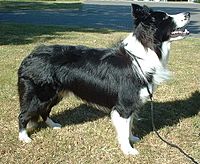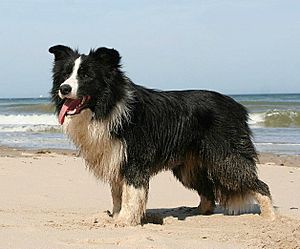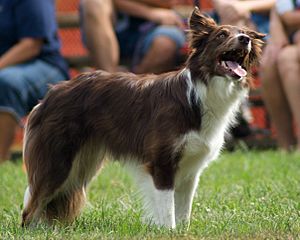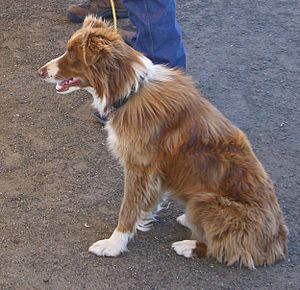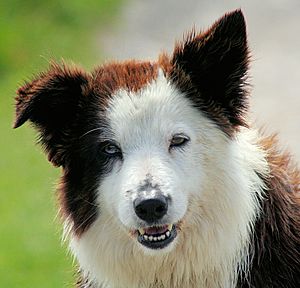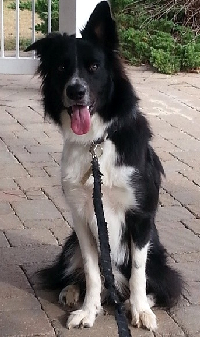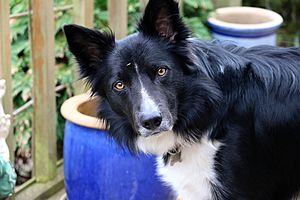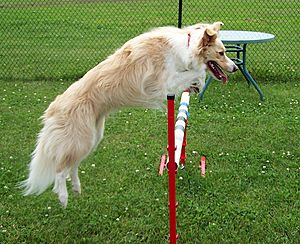Border Collie facts for kids
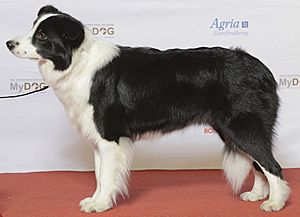 |
|||||||||||||||||||||||||||||
| Other names | Scottish Sheepdog (sometimes confused with the related Welsh Sheepdog) |
||||||||||||||||||||||||||||
|---|---|---|---|---|---|---|---|---|---|---|---|---|---|---|---|---|---|---|---|---|---|---|---|---|---|---|---|---|---|
| Origin | United Kingdom Scottish borders |
||||||||||||||||||||||||||||
|
|||||||||||||||||||||||||||||
| Domestic dog (Canis lupus familiaris) | |||||||||||||||||||||||||||||
The Border Collie is a breed of dog that originated along the English-Scottish border. It is one of the most intelligent dog breeds. They have been used to herd livestock for over 300 years. It is also famous for a pet or show-dog. The border collie is about 20 inches (51 cm) in height and weighs 31 to 50 pounds (14 to 23 kg). It is usually a long-haired dog. Its coat is often black and white in color.
Contents
Description
In general, Border Collies are medium-sized dogs with a moderate amount of coat, which is most often thick and sheds often. They have a double coat that varies from smooth to rough and is occasionally curled. Whilst black and white is most commonly seen colour pattern of the Border Collie, the breed appears in just about any colour and pattern known to occur in dogs. Some of these include black tricolour (black/tan/white), liver and white, and red tricolour (red/tan/white) have also been seen regularly, with other colours such as blue, lilac, red merle, blue merle, brindle, and Australian red (also known as ee red, blonde, recessive red, or gold) which is seen less frequently. Some Border Collies may also have single-colour coats.
Eye colour varies from brown to blue, and occasionally eyes of differing colour occur; this is usually seen with merles. The ears of the Border Collie are also variable — some have fully erect ears, some fully dropped ears, and others semi-erect ears (similar to those of the rough Collie). Although working Border Collie handlers sometimes have superstitions about the appearance of their dogs (handlers may avoid mostly white dogs due to the unfounded idea that sheep will not respect a white or almost all white dog), in general a dog's appearance is considered by the American Border Collie Association to be irrelevant. It is considered much more useful to identify a working Border Collie by its attitude and ability than by its looks.
Dogs bred for show are more homogeneous in appearance than working Border Collies, since to win in conformation showing they must conform closely to breed club standards that are specific on many points of the structure, coat, and colour. Kennel clubs specify, for example, that the Border Collie must have a "keen and intelligent" expression, and that the preferred eye colour is dark brown. In deference to the dog's working origin, scars and broken teeth received in the line of duty are not to be counted against a Border Collie in the show ring. The males' height from withers comes from 48 to 56 centimetres (19 to 22 in), females from 46 to 53 centimetres (18 to 21 in).
Temperament and needs
Border Collies require considerably more daily physical exercise and mental stimulation than many other breeds. The Border Collie is an intelligent dog breed; in fact, it is widely considered to be the most intelligent dog breed. Although the primary role of the Border Collie is to herd livestock, this breed is becoming increasingly popular as a companion animal.
In this role, due to their working heritage, Border Collies are very demanding, playful, and energetic. They thrive best in households that can provide them with plenty of play and exercise, either with humans or other dogs. Due to their demanding personalities and need for mental stimulation and exercise, many Border Collies develop problematic behaviours in households that are not able to provide for their needs. They are infamous for chewing holes in walls, furniture such as chairs and table legs, destructive scraping and hole digging, due to boredom. Border Collies may exhibit a strong desire to herd, a trait they may show with small children, cats, and other dogs. The breed's herding trait has been deliberately encouraged, as it was in the dogs from which the Border Collie was developed, by selective breeding for many generations. However, being eminently trainable, they can live amicably with other pets if given proper socialisation training.
Before taking on the breed as a household pet, potential owners should be sure they can provide regular exercise commensurate with the collie's high energy and prodigious stamina. A working collie may run many miles a day, using its experience, personality and intelligence to control challenging livestock, and these dogs will be distressed and frustrated if left in isolation, ignored or inactive. Like many working breeds, Border Collies can be motion-sensitive and may chase moving vehicles and bicycles, but this behaviour can be modified by training. Some of the more difficult behaviours require patience, as they are developmental and may disappear as the dog matures.
Health
Life span
The natural life span of the Border Collie is between 10 and 14 years, with an average lifespan of 12 years. The median longevities of breeds of similar size are usually 12 to 13 years.
Leading causes of death are cancer (23.6%), old age (17.9%) and cerebral vascular afflictions (9.4%).
Common health problems
Hip dysplasia, Collie eye anomaly (CEA), and epilepsy are considered the primary genetic diseases of concern in the breed at this time. CEA is a congenital, inherited eye disease involving the retina, choroid, and sclera that sometimes affects Border Collies. In Border Collies, it is generally a mild disease and rarely significantly impairs vision. However, other eye conditions such as PRA slowly disintegrates the retina and can cause Border Collies to lose almost all of their vision at night which can progress into complete daytime blindness. There is now a DNA test available for CEA and, through its use, breeders can ensure that they will not produce affected pups. There are different types of hip testing available including OFA (Orthopedic Foundation for Animals) and PennHip. Radiographs are taken and sent to these organizations to determine a dog's hip and elbow quality.
History
The Border Collie is descended from landrace collies, a type found widely in the British Isles. The name for the breed came from its probable place of origin along the Anglo-Scottish border. Mention of the "Collie" or "Colley" type first appeared toward the end of the 19th century, although the word "collie" is older than this and has its origin in the Scots language. It is also thought that the word 'collie' comes from the old Celtic word for useful. Many of the best Border Collies today can be traced back to a dog known as Old Hemp.
In 1915, James Reid, Secretary of the International Sheep Dog Society (ISDS) in the United Kingdom first used the term "Border Collie" to distinguish those dogs registered by the ISDS from the Kennel Club's Collie (or Scotch Collie, including the Rough Collie and Smooth Collie) which originally came from the same working stock but had developed a different, standardised appearance following introduction to the show ring in 1860 and mixture with different types breeds.
Old Hemp
Old Hemp, a tricolour dog, was born in Northumberland in September 1893 and died in May 1901. He was bred by Adam Telfer from Roy, a black and tan dog, and Meg, a black-coated, strong-eyed dog. Hemp was a quiet, powerful dog to which sheep responded easily. Many shepherds used him for stud and Hemp's working style became the Border Collie style. All pure Border Collies alive today can trace an ancestral line back to Old Hemp.
Wiston Cap
Wiston Cap (b. 28 Sep. 1963) is the dog that the International Sheep Dog Society (ISDS) badge portrays in the characteristic Border Collie herding pose. He was a popular stud dog in the history of the breed, and his bloodline can be seen in most bloodlines of the modern day Collie. Bred by W. S. Hetherington and trained and handled by John Richardson, Cap was a biddable and good-natured dog. His bloodlines all trace back to the early registered dogs of the stud book, and to J. M. Wilson's Cap, whose name occurs 16 times within seven generations in his pedigree. Wiston Cap sired three Supreme Champions and is grand-sire of three others, one of whom was E. W. Edwards' Bill, who won the championship twice.
Introduction to New Zealand and Australia
Collies were listed as imports to New Zealand as early as 1858, but the type was not specified. In the late 1890s James Lilico (1861?–1945) of Christchurch, New Zealand, imported a number of working dogs from the United Kingdom. These included Hindhope Jed, a black, tan and white born in Hindhope, Scotland in 1895, as well as Maudie, Moss of Ancrum, Ness and Old Bob.
It is unclear whether Hindhope Jed was a descendant of Old Hemp. Born two years after him, she is mentioned in a British Hunts and Huntsmen article concerning a Mr John Elliot of Jedburgh:
Mr Elliot himself is well known for his breed of Collies. His father supplied Noble to the late Queen Victoria and it was from our subject that the McLeod got Hindhope Jed, now the champion of New Zealand and Australia.
At the time of her departure to New Zealand, Hindhope Jed was already in pup to Captain, another of the then new "Border" strain. Hindhope Jed had won three trials in her native Scotland, and was considered to be the "best to cross the equator".
In 1901 the King and Mcleod stud, created by Charles Beechworth King (b. 1855, Murrumbidgee, NSW), his brother and Alec McLeod at Canonbar, near Nyngan (north-west of Sydney), brought Hindhope Jed to Australia, where she enjoyed considerable success at sheep dog trials.
Breed standards
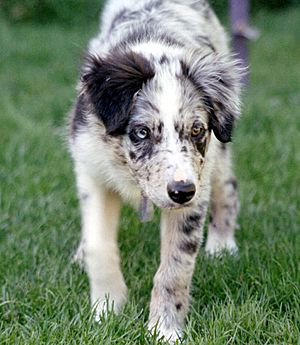
There are two types of tests, or standards, to determine the breeding quality of a Border Collie: the original ISDS sheepdog trial and appearance.
ISDS Sheepdog Trial
The original test is the ISDS sheepdog trial. It is still used today, where a dog and handler collect groups of livestock and move them quietly around a course. There are certain standard elements to this test depending on the level: national or international. For both levels, sheep must be gathered as calmly as possible without being distressed. For a national competition, normally held between England, Ireland, Scotland, and Wales, trials run over a 400-yard course. International courses use a 400-yard course for the qualifying trials, but on the third and final day, trials are held in a course of 800 yards. The international test involves a "double fetch", where the sheepdog must gather 10 sheep from 800 yards away, bring them on an angle to the center of the field, and then be sent back in another direction to gather another 10 sheep, also placed 800 yards from the handler. Five of those 20 sheep will have collars on, and at the end of a triangular drive, the sheep are gathered into a circular "shedding ring" and the 15 sheep without collars driven away as the five collared sheep are kept inside the ring and then penned. Sheepdogs must be directed through obstacles at varying distance from the handler, and then the dog must demonstrate the ability to do work close at hand by penning the sheep and sorting them out.
Appearance
In nearly every region of the world, the Border Collie is now also a breed which is shown in ring or bench shows. For the people who participate in these events, the Border Collie is defined by the breed standard, which is a description of how the dog should look. In New Zealand and Australia, where the breed has been shown throughout most of the twentieth century, the Border Collie standards have produced a dog with the longer double coat (smooth coats are allowed), a soft dark eye, a body slightly longer than tall, a well-defined stop, semi-pricked ears, as well as a gentle and friendly temperament. This style of Border Collie has become popular in winning show kennels around the world, as well as among prestigious judges. Breed standards state that its tail must be slightly curved and must stop at the hock. The fur must be lush. It should show good expression in its eyes, and must be intelligent. It is energetic with most commonly a black and white coat (sometimes brown). It should have a very strong herding instinct.
Away from breed standards, short haired Border collie variants are also found, offering householders a less demanding task clearing year-round shed hair. Crossing collies with German shepherd dogs produces a strong intelligent hybrid of intermediate size, popularly named a "shollie", used as a working dog with livestock and as an animal companion.
Activities
Border Collies are one of the most popular breeds for dog agility competitions. They also excel at competitive obedience, showmanship, flyball, tracking, and USBCHA Sheepdog trials and herding events.
Livestock work
Working Border Collies can take direction by voice and by whistle at long distances when herding. Their great energy and herding instinct are still used to herd all kinds of animals, from the traditional sheep and cattle, to free range poultry, pigs, and ostriches. They are also used to remove unwanted wild birds from airport runways, golf courses, and other public and private areas.
The use of dogs for herding sheep makes good economic sense for many farmers. In a typical pasture environment each trained sheepdog will do the work of three humans. In vast arid areas like the Australian Outback or the Karoo Escarpment, the number increases to five or more. Attempts to replace them with mechanical approaches to herding have only achieved a limited amount of success. Thus, stock handlers find trained dogs more reliable and economical.
Shepherds in the UK have taken the most critical elements of herding and incorporated them into a sheepdog trial. The first recorded sheepdog trials were held in Bala, North Wales, in 1873. These competitions enable farmers and shepherds to evaluate possible mates for their working dogs, but they have developed a sport aspect as well, with competitors from outside the farming community also taking part.
In the USA, the national sanctioning body for these competitions is the USBCHA. In the UK it is the International Sheep Dog Society, in Canada the Canadian Border Collie Association (CBCA) and in South Africa it is the South African Sheepdog Association.
Dog sports
Border Collies excel at several dog sports in addition to their success in sheepdog trials. Because of the high instinct of herding, they are excellent at this sport. Herding instincts and trainability can be tested for when introduced to sheep or at noncompetitive instinct tests. Border Collies exhibiting basic herding instincts can be trained to compete in sheepdog trials and other herding events. They perform well at some higher jump heights at dog agility competitions, so much so that in England, competitions often include classes for ABC dogs, "Anything But Collies".
The Border Collie's speed, agility, and stamina have allowed them to dominate in dog activities like flyball and disc dog competitions. Their trainability has also given them a berth in dog dancing competitions.
Border Collies have a highly developed sense of smell and with their high drive make excellent and easily motivated tracking dogs for Tracking trials. These trials simulate the finding of a lost person in a controlled situation where the performance of the dog can be evaluated, with titles awarded for successful dogs.
Notable Border Collies
- Rico, who was studied for recognising up to 200 objects by name. Another Border Collie, Betsy, was found to have a vocabulary of over 300 words.
- As of 2010, the Border Collie Chaser has a vocabulary of 1022 words and is able to recognise objects by the groups they belong to.
- Shep, who was the long-term companion to John Noakes of the BBC's Blue Peter and Meg, companion of Matt Baker, former presenter of the same show.
- Striker, who is the current Guinness World Record holder for "Fastest Car Window Opened by a Dog" at 11.34 seconds.
- Jean, also known as the Vitagraph Dog, who was the first canine movie star (owned and trained by Laurence Trimble)
- Rex and Fly were two Border Collies that appeared in the Academy Award winning 1995 film, Babe and, partially, in the sequel Babe: Pig in the City.
- Jag, the "First Dog" of Montana, frequently accompanies Governor Brian Schweitzer.
- Bandit, the stray Scottish Border Collie from TV series Little House on the Prairie was Laura Ingalls' second dog on the show.
Images for kids
See also
 In Spanish: Border collie para niños
In Spanish: Border collie para niños


